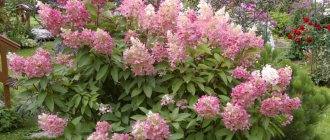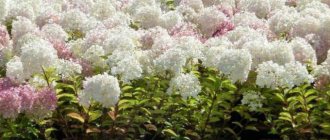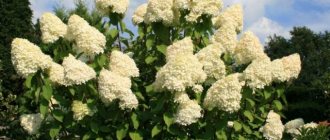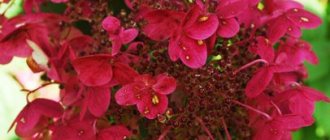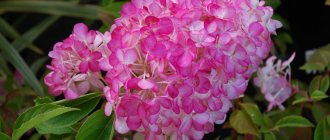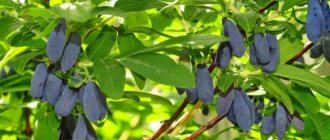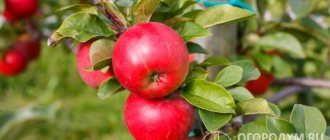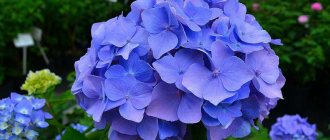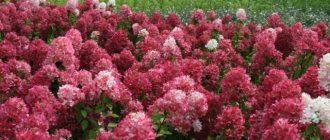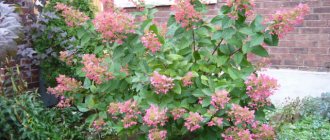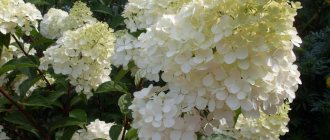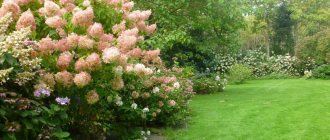Hydrangea paniculata “Kiushu” in the Kostroma village
Hydrangea bush near the summer house.
Not every shrub can organically fit into the appearance of a Russian country estate. Summer residents who have houses in the village are now planting various newfangled plants - flowers, shrubs, and trees. But how this hydrangea takes root, how modestly and quietly it grows, how calmly it bestows its beauty, how it survives our winters (and this winter it was -47 on the site) everyone should know. "Kyushu" - originally from Japan, described for the first time in 1926. I got it 15 years ago. I planted a small twig 20 cm high in a pot in the best place from my point of view. We quickly arrived in the village for a few days to mow the grass, clean the house, and then spend a vacation here in August. But, being a city dweller, without studying your site, it was impossible not to make mistakes. I had no idea that I would have to endure the poor fellow 2 more times.
First flowerbed
Now it’s funny to look at such photos, but we had to start somewhere. Ultimately, Kyushu settled down right next to the wall of this old house.
May rain waters
This does not always happen; usually the water manages to pass through the pipes and calmly flow into the river. I had to move the bush to the left to the corner of the house. Our site is on a slope, there are drains for water, a whole well-thought-out system of them. It is with the study of this issue that landscaping should always begin.
There are lights near the wall. The branches are tied after wintering. It was a long time ago.
This house is nothing more than a piece of light taken from the roof of our 115-year-old village house. Then there were plantings, and sometimes “plantings,” mistakes, and dragging plants from one place to another. Like most summer residents. Well, and repairs, reconstructions, alterations, construction... As a result, the hydrangea found a permanent place, closed from the northern winds by a wall.
September 17, 2017
This hydrangea can grow in both sunny and semi-shady places, as long as it is not blown by the winds. Another important condition for the successful growth of Kyushu is the suitable soil composition. Loams and clay are very good, but diluted with red peat. This is high-moor peat, which can now be purchased in gardening stores, and low-lying peat is black (it is usually included in nutrient soils). And this one is also for sale. Peat from raised bogs is characterized by high acidity, low degree of decomposition, it is fibrous and moisture-absorbing. Lastly, it is low in nutrients. Hortesia loves fertile and acidic soil, which you will have to make yourself, enriching it with organic matter. You can completely get by by adding pine or spruce litter to the planting hole, as well as as mulch. For sandy soils, the amount of peat and litter should be increased.
My hydrangea grows precisely on the sand-gravel mixture (SGP), which was used to construct the drainage system. When planting, the pot with the plant should be immersed in a bucket of water for 30 minutes, so that it is completely covered. 2 drops of biostimulator HB-101 per 10 liters of water will help the bush take root faster. Air bubbles will come out; you can safely plant them directly in a dry hole. There is no need to cut the tangled roots, as when planting rhododendron, you need to plant it as is, and then mulch it. The roots of the plant are superficial; active loosening with a tool can damage them, so it is better to remove weeds by hand. For a young hydrangea, this is an important condition for growth, but my Kyushu is already an adult, although they believe that its lifespan is up to 60 years. How and who counted is not entirely clear. Every year I mulch the tree trunk circle with pine bark and add peat, and my husband throws stones there when clearing drains.
The tree trunk circle was overgrown with grass after my 1.5 month absence
At first I removed them, then I stopped, realizing that the hydrangea was doing great.
Kyushu is blooming. Bush in the form of a bouquet.
Like all hydrangeas, Kyushu loves watering, especially in dry weather. The shape of the leaves will immediately indicate the lack of moisture. Watering is very important for young bushes, mine can already live quietly on its own, but it is planted next to a drain, and the plot is sloping. When feeding hydrangeas, you must remember that they do not tolerate manure and ash. I haven’t used mineral fertilizers on the site for a long time, so I feed my paniculate hydrangeas only with herbal infusions with the addition of the “Shine” biological product. There are usually 3 feedings - in early spring, at the time the flower stalks emerge and at the end of August (advance for the next season). This year there was a harsh winter, and the bush did not receive any fertilizing, I think that is why it does not bloom as luxuriantly as last season, and the leaves are generally not large. There was enough moisture in the summer.
Reverse side of Kyushu leaf
Usually the leaf length is up to 12 cm, the leaf itself is hard, leathery, and difficult to tear. The veins on the reverse side are slightly pubescent. By autumn all the foliage turns yellow. Kyushu blooms with panicles up to 30 cm long.
Kyushu Flowers
The inflorescences consist of sterile and fertile flowers. There are both white and cream shades, and pinkish ones will appear as the weather gets colder.
Snow on Kyushu
There are fewer sterile ones; fertile ones always predominate - small, white ones. But how they look even at night!
At night at dusk
And there is a slightly perceptible delicate aroma. For abundant flowering, hydrangea needs regular pruning. In the fall, if you really want to, you can cut off the flower stalks. I don't trim them. I tie the branches for the winter so that the bush is not broken by snow.
It snowed. 2015 January 2017
Since the bush has strong and elastic branches, and the lower ones are removed, it is easier to care for hydrangea. But by regularly adding new portions of snow, since the paths have to be cleaned, in the spring you can end up with a broken bush. In the spring, before the buds open, it is necessary to carry out severe pruning, as a rule, to healthy buds; frozen shoots will be clearly visible. Annual shoots also need to be shortened, leaving 3-5 pairs of buds. At the same time, you can cut cuttings for rooting.
Branched branch - for cuttings
Such old branches also take root well, but to do this they need to be covered with a mini-greenhouse.
cuttings from spring 2021
The greenhouse has now been removed, but the bush needs to be replanted next season. Now I grow cuttings of various plants not in a seedling bed, but in the shade of trees in the forest behind our site.
At the end of the path - cuttings
Hydrangea is very moisture-loving; the sun is destructive for cuttings. Propagation by layering is another way to get a new plant.
Reproduction
Hydrangea Kyushu is bred in several ways:
- Seeds. A soil mixture of leaf soil, peat and sand is poured into a convenient container. Planting material is immersed in it and lightly sprinkled with earth. It is moistened from above using a spray bottle. The first shoots of Kyushu hydrangea can be seen on the 45th day. Before this, the soil is regularly moistened. After the sprouts appear, you can remove the film and after a while pick up the plantings into small cups. When 4 strong leaves are formed, they are planted in small pots. Next comes a hardening period so that the plants get used to fresh air. After 2 years, the sprouts are transferred to the garden, immediately choosing a permanent place.
- By cuttings. It is necessary to select healthy branches that have several formed buds. First, they are rooted in a container of water and then transferred to nutritious soil. If the Kyushu hydrangea cutting is planted directly into the ground, its lower leaves are cut off completely, and the upper leaves are cut off by ½ of the length. There must be a transparent dome on top to create a greenhouse effect.
The same care for rooted cuttings as for sprouts obtained from seeds - By layering. The lower shoot of the Kyushu hydrangea is bent to the ground and sprinkled with a layer of soil, firmly fixing it. The upper part of the branch remains above the ground (it is tied to a support). After the side shoots appear, they are earthed up in several stages. Rooted cuttings are carefully separated and transferred to a previously prepared place.
Description and appearance of Kyushu hydrangea
Hydrangea paniculata kyushu (in Latin - hydrangea paniculata kyushu) is a deciduous shrub that grows in a wide variety of soils, excluding marshy areas and sands.
Hydrangea variety Kyushu
When describing the variety, it is worth noting the following features:
- The root system is superficial, but quite spreading. The diameter exceeds the size of the bush in diameter.
- The branches grow upward and slightly to the sides, which allows the bush to form a hemispherical shape with a diameter of about 2.5 m and a little more, under very favorable conditions.
- The leaves are elongated oval, rich green.
- Petioles are brownish-red.
- The flowers are small, but when collected in pyramidal inflorescences up to 30 cm long, they form magnificent white clusters with a delicate aroma.
- After flowering, a box with seeds is formed. The seed material itself is quite small and abundant.
- The crop is winter-hardy, which allows it to be grown without problems in the middle zone and northern latitudes.
For reference! Some inexperienced gardeners call this hydrangea variety Kuishi or even Kyushu - this name is incorrect.
In landscape design
Origin
Hydrangea is one of the shrubs that has been known since ancient times. It is mentioned in records of archaeological excavations in Japan, Asia, America, and China.
Hydrangea Kyushu decorates the garden with its graceful blooms
This variety is called paniculata hydrangea Kyushu or Japanese hydrangea. In Asian countries the shrub is called Kyushu Ajisai. The plant came to Europe thanks to physician Philipp Franz von Siebold in 1829.
The bush has an original fan shape and grows up to three meters in height. In this case, you can form a bush using pruning. All the sophistication and beauty of the plant appears only after several years of growth.
Important! The crown of a hydrangea bush can only be formed on a three-year-old plant.
Planting hydrangeas in open ground
In order for the Kyushu hydrangea to feel as comfortable as possible and to take root faster, it is necessary to plant in early spring. This rule is suitable for all regions with different climates.
But in the southern parts you can plant before winter. Temperatures here are not so low, so the young bush will be able to overwinter painlessly. But in this case, it is advisable to use for planting only plants that have formed their own root system, that is, plant layering or already well-rooted cuttings.
The second point that you need to pay close attention to is a suitable place to plant the bush. Hydrangea is quite sensitive to light - it needs intense lighting, but without direct sunlight. It is for this reason that it will be best if this flower is planted in light partial shade.
Optimal growing location
Note! Too much shade will cause sluggish or no flowering.
It is also necessary to take into account the proximity of other plants. It is better if these are small shrubs or herbaceous crops. Such a neighborhood will not negatively affect either the hydrangea or its neighbors.
It is also necessary to avoid choosing places where the wind constantly blows. The branches of the bush are fragile and brittle, so young seedlings may simply die.
Important! The presence of trees of any size next to a hydrangea bush will choke the growth of the latter. This is due to the fact that Kyushi has a spreading root system, which will be drowned out by the more powerful roots of the tree. As a result, the hydrangea will be sluggish, weak and underdeveloped.
As for the soil itself, for the Kyushu variety it can be anything, excluding too swampy terrain or an abundance of sand in the soil. Of course, the more nutritious the soil, the more intense and abundant the flowering of the variety will be.
Therefore, when planting, you can add superphosphate (about 30-50 g), nitrogenous fertilizers (20 g), substances containing potassium (15 g), peat soil for alkaline soils and humus or manure-based fertilizer about 5-7 into the hole for the bush when planting kg. Planting taking into account these features will give excellent results - growth will be intense, and flowering will be abundant and lush.
A suitable place for Hydrangea Kyushu on a trunk
Paniculata hydrangea Kyushu: photo of the variety
Hydrangea Kyushu - hydrangea paniculata kyushu - prefers open light areas or partial shade. In direct sunlight, the plant will not feel very good, since the soil there will dry out quickly, and hydrangea is not tolerant of drought. An area located in complete shade is also not suitable. There the plant will not bloom or the flowers will be very faded and in small quantities. When choosing a location, you should give preference to areas with good natural light. You cannot plant bushes next to trees, since the latter have a powerful and large root system that will take away moisture and nutrients from the hydrangea. It is also important that the site is protected from strong winds that can break the fragile and thin shoots of young seedlings. Soil preparation:
The soil for Kyushu hydrangea on a trunk is prepared two weeks before planting so that the soil has time to settle. The depth of the planting holes should be 40 centimeters and the width 50 x 60 centimeters. A drainage layer of 8 centimeters of broken brick, crushed stone or expanded clay is laid on the bottom. Next you need to make a soil mixture of 60 g. phosphate, 20 gr. potassium, 20 gr. nitrogen fertilizers (if planting is carried out in the spring), peat, in this case it depends on the level of acidity, the higher it is, the less fertilizer, and 8 kg. humus. All ingredients must be well mixed. If the soil is sandy, then a 4 cm layer of clay is added there.
It is important to know that the introduction of fresh manure and lime is prohibited. These ingredients can destroy the plant. It is also important to remember that the hole must correspond to the size of the root system.
Reproduction methods
You can get a plant on your site in completely different ways:
- Planting seed material. But in this case, it will not be possible to get at least a small bush of Hydrangea paniculata Kyushu soon. The seed method is the most labor-intensive and long-term.
- By cuttings. In this case, it is important to carry out the manipulation technologically correctly, ensuring all sanitary conditions. It will take time for part of the plant to take root.
- Layering is the easiest and fastest way to get a new paniculate hydrangea bush.
How to care
Despite the fact that Kyushu hydrangea is quite unpretentious, it still needs to create suitable conditions:
- The bush responds very well to mulching with pine needles. It protects the plant from pests and from excessive drying out.
- Provide regular watering. It is best to do it late in the evening or early in the morning. With this bush it is better to adhere to the rule - an excess of moisture will not harm, but a lack will destroy it.
- The more nutrients are added to the soil, the longer, more colorful and more abundant the hydrangea will bloom. It is advisable to apply any types of fertilizing approximately 2 times every month during budding and active flowering.
- Provide the bush with regular pruning. This is necessary not only for better growth, but also to form a suitable bush shape, for example, a standard.
Note! Such plants look especially decorative when creating landscape design.
Shrub pruning
Shrub pruning is carried out regularly:
- In early spring, it must be carried out in order to ensure active growth and production of young shoots.
- In the fall, before wintering, the bush is pruned in order to provide it with proper care and comfortable tolerance to low temperatures.
- Pruning is carried out according to the presented scheme.
Trimming methods - standard form
When and how much to water
In the spring you need to add moisture approximately once every 7-10 days. It is necessary to focus on the intensity of precipitation in a particular season.
Application in landscape design
In landscape design, this variety is used for landscaping the area. It is planted both in single plantings and in compositions with other flowers and shrubs. For example, hydrangea will look great in combination with roses, Japanese anemone, thuja, juniper and many other plants.
The Kyushu variety can be a wonderful addition to a stone garden or highlight the beauty of a fountain. It can also be planted in the form of a hedge, which will serve an aesthetic function near the house, and a strengthening function on the slope.
Winter hardiness of the variety
The description of the Kyushu hydrangea variety makes it clear that the plant is winter-hardy. But you need to understand what level of cold it can tolerate.
The fact is that in the southern regions and where frosts do not drop too low, the bush can overwinter without additional shelter. But this is only true for an adult plant whose age is more than 3 years. Young shrubs need careful cover using spruce branches or special material.
If frosts drop to -20..-30°C and persist for a long period, then it is advisable to wrap adult bushes as well. This will avoid the loss of the varietal bush.
Shelter for the winter
Pest and disease control
The more suitable conditions are created for hydrangea, the less likely it is for diseases and pest attacks. But if this could not be avoided, then you need to know:
- Cuprozan, Captan, Fundazol or Bavistin will help get rid of gray rot;
- for white rot - the same Fundazol, Zuparen;
- Copper oxychloride and Ferbam are effective against white spotting;
- and iron sulfate or colloidal sulfur will help fight rust.
Note! The hydrangea variety is resistant to exhaust gases, so it is often planted along fences and highways, achieving the most attractive design for this part of the site.
By following all the above recommendations and care rules, you can get an attractive adult plant on your site that will meet all the requirements. And the long flowering will please the owners.
Japanese hydrangea Kyushu in your garden
The wild ancestor of these paniculate hydrangeas actually grows on the island of Kyushu in the Japanese archipelago, has strong red-brown branches and an openwork fan-shaped crown of rich green, jagged, slightly glossy leaves with red petioles.
From July to October, the tall, up to three meters, bush is covered with white inflorescences, emitting a honey aroma.
As they fade, they acquire a pink tint.
In autumn the leaves turn yellow and fall off towards winter.
The paniculate hydrangea kyushu retains the same qualities in landscape gardening. Sufficient winter hardiness (up to -34ºС) allows you to successfully grow this shrub in the middle zone, in open ground conditions.
Characteristic
The plant belongs to the species Hydrangea paniculata of the Hydrangea genus of the Hydrangeaceae family. Form: deciduous shrub. Grows on any soil except clean sand and swamps, still preferring acidic soil. Tolerates light shade and partial shade well. Under direct sunlight, it loses its luxurious decorative appearance. Distinctive features of the Hydrangea paniculata variety Kyushu:
- The root system is superficial, sensitive to damage. The size exceeds the crown of the bush in adulthood.
- The branches are upright, rigid, red-brown in color. Crown diameter up to 3 meters.
- The leaves are ellipsoid, green in color with red petioles.
- The flowers are fragrant and white. They form loose cone-shaped inflorescences 20-35 cm long. By autumn they can acquire a slightly pinkish tint.
Kyushi
- The fruit is a capsule 1-3 mm. Seeds - small, numerous
- Propagated by seeds, cuttings, layering. Branches for rooting are taken that are flexible when pruning the plant in the spring, or from June 10 to 15.
- The culture is characterized by winter hardiness and at the same time moisture-loving properties.
Paniculata hydrangea Kyushu in the garden
Selecting a location
Adult specimens have difficulty recovering from transplantation. Therefore, the place in which the seedling will grow and develop must be long-term.
The landing site should be sheltered from strong winds and sufficiently well lit ; Shading up to partial shade is possible.
Priming
The soil should be acidic and combine looseness with sufficient nutritional value.
Its composition may include peat, humus, turf, leaf soil and sand in equal quantities.
A mixture of peat and humus with garden soil in equal proportions is also used.
Planting
The best time for placement in open ground is spring . Bushes that have overwintered in the ground can be planted soon after the soil thaws. Greenhouse plants with leaves should be planted only in late spring, after the frost period has ended.
The dimensions of the planting hole should provide space for the growth of the root system. The usual “measurements” are length and width from 0.5 to 0.8 meters. The depth may be somewhat less, since surface roots grow wider than deep.
If the soil is clayey, the bottom is provided with a drainage layer of crushed stone, pebbles, brick or ceramic scrap.
Sandy soils, on the contrary, are compacted with a layer of clay, which is placed at the bottom of the planting pit.
A layer of soil mixture and carefully straightened root system, previously moistened in a bucket of water, are poured into the prepared planting hole.
Add soil and compact it carefully. As a result, the root collar should be flush with the soil surface, but not deeper.
Watering
The optimal water for irrigation should be soft , ideally rainwater.
Tap water should be well defended. From time to time it is useful to add a little lemon juice or vinegar .
Panicle hydrangea Kyushu, compared to other types of hydrangeas, is relatively drought-resistant, but in dry summers and when there is a lack of moisture in spring, regular,
abundant watering is necessary.
Top dressing
The plant responds well to complex mineral nutrition. The best option is mixtures developed and intended for hydrangeas . They can be periodically supplemented with organic compounds.
The timing of fertilizer application is coordinated with the main phases of growth and development:
spring feeding supports the formation of young shoots;
June promotes abundant formation of buds;
summer ones , during the flowering period, prolong it. These feedings are carried out twice a month. The potassium and phosphorus components increase, while the nitrogen component decreases.
Autumn , before the dormant period, includes superphosphate and potassium sulfate.
Growth and pruning
Bushes that grow quickly (25 cm per year) can and should be pruned in spring , since flower buds form on the shoots of the current year and open in the same summer.
Moreover, severe pruning of shoots to the level of three to five buds stimulates the massive formation of powerful young shoots with large inflorescences.
Old bushes are rejuvenated by pruning them to the level of perennial wood or even to a stump.
Thoughtful pruning can shape this hydrangea into graceful tree .
For this purpose, a vertical leading shoot and 4-5 “accompanying” lateral shoots are isolated on a young plant, the remaining shoots are removed, and the remaining lateral shoots are pinched. The “leader” is allowed to reach a height of 1-1.5 meters.
Then its top is cut off, thereby stimulating the formation of skeletal branches of the crown. The lateral “support” is removed. Form a crown as it grows.
Wintering
Adult paniculate hydrangeas do not need winter shelter. Young plants, especially during the first wintering, are bent to the ground and covered with spruce branches.
To prevent the branches from breaking off, they are tied into one bundle and attached to a reliable support.
Bloom
The abundant flowering of fragrant “panicles” begins in July and continues until mid-autumn.
The shade of the inflorescences depends on their age - the older, the pinker - and on the acidity of the soil: the flowers become brighter the more acidic the soil.
Planting and caring for Hydrangea paniculata Kyushu
The most optimal time for planting Kyushu hydrangea is spring. It is necessary to wait until the snow cover has completely melted and the soil has warmed up. If we are talking about the southern regions, then it is permissible to start planting Kyushu hydrangea in the fall, no later than mid-September. It is important that the seedling has a well-formed root system. Young bushes with weak roots are planted only in the summer so that they have time to fully grow stronger.
Selection and preparation of a landing site
For normal growth and development of Kyushu hydrangea, a well-lit place is required, but without contact with direct sunlight. Otherwise, the shoots will lose their decorative effect, and the soil will dry out too quickly. However, complete shade is also not suitable.
The golden mean will be an area where there will be a sufficient amount of soft, diffused light for most of the day. It is also worth considering the proximity of trees and other shrubs. They should not greatly shade the hydrangea or take away moisture and nutrients from it.
Attention! Kyushu hydrangea seedlings have rather fragile shoots, so they additionally require protection from drafts and gusts of wind. Otherwise, the branches will always be broken off, which will have a bad effect not only on the appearance of the bush, but also on its condition.
The area must be completely cleared of weeds, the soil must be dug up and leveled. A few days before the planned planting of the Kyushu hydrangea, you can begin to prepare the hole. Its width is 55-60 cm, and its height is 40 cm. It takes a little time for the soil to completely subside. Drainage is poured into the bottom of the pit in the form of expanded clay, crushed brick or crushed stone (layer height no more than 8 cm).
Next come several types of fertilizers (nitrogen, potassium, and superphosphate). Nitrogen is especially important in the spring, as it actively stimulates vegetation. In the fall, it is practically not used, because the young branches that have grown back will not withstand the upcoming cold weather. After fertilization, peat is poured (to obtain optimal soil acidity) and humus. It is prohibited to use lime or fresh manure, otherwise the root system will die. All components must sit in the pit to allow them to shrink. It is best to choose a dry week so that the planting hole does not become flooded with water.
Landing rules
The seedling is immersed in the “settled” planting hole. Before transplanting Kyushu hydrangea shoots, the roots are shortened slightly to stimulate their further growth. During spring planting, the shoots of Kyushu hydrangea are also pruned, leaving only 3-4 buds. The seedling is slightly buried, and the root collar is sprinkled with a small layer of soil (just a couple of cm). After watering, it will lower and the neck will be above the soil level. Afterwards, the tree trunk circles are mulched. To do this, use any available materials: dry sawdust, nut husks, straw or pine needles.
Hydrangea Kyushu is best planted in spring
Watering and fertilizing
Hydrangea Kyushu on a trunk needs moisture, so it needs regular watering as the soil dries out. It is best to moisten the soil in the morning to protect the bush from burns and prevent rapid evaporation of water. Drought is contraindicated for Kyushu hydrangea; it tolerates a slight stagnation of moisture more easily than its complete absence.
No less important for Kyushu hydrangea are feeding. Apply 4 times per season:
- The first occurs at the very beginning of spring, when active sap flow begins. During this period, organic matter is introduced (solutions based on manure or bird droppings).
- The second is during the formation of buds. To do this, use a mixture of superphosphate with urea and potassium sulfate, diluted with water.
- The third feeding is applied in mid-summer. Complex mineral fertilizers in granules give good results.
- The Kyushu hydrangea is fed for the fourth time before winter, using special nitrogen-free preparations.
Pruning Kyushu hydrangea
A lush bush without proper care will quickly lose its shape. However, pruning Kyushu hydrangea, in addition to its aesthetic function, has an overall beneficial effect on the plant. If you prune the hydrangea before the buds begin to open, in the future it will delight you with generous and long flowering. Without this procedure, flowers may not appear at all.
At the end of autumn, all inflorescences of the Kyushu hydrangea are cut off, as well as weak and rotting shoots. In spring, do the same with frozen branches. To rejuvenate bushes, they resort to radical pruning right down to the stump.
Preparing for winter
Young plants, especially first-year ones, should be carefully insulated. All inflorescences are cut off from the shoots of the Kyushu hydrangea, the stems are bent to the ground and slightly pressed down so that they do not straighten. The branches and part of the soil are covered with special agrofibre or spruce branches on top.
Mature strong bushes do not react to frost. It is enough to simply tie their branches and fix them on a support. This will protect them from breaking off by the wind and sagging under the weight of snow. You can see how to properly prune Kyushu hydrangea in the video:
Diseases and pests
Hydrangea in a site with optimal conditions for it is resistant to diseases.
On soils that are limed or oversaturated with humus, the plant may develop chlorosis: the leaves, except for the central vein, become yellowish-light.
In this case, several waterings are carried out with a solution of potassium nitrate with a concentration of 4 g/l, and after 3 days - with a solution of ferrous sulfate of the same concentration.
Downy mildew , characterized by dark, oily, gradually spreading spots on leaves and stems, appears at a temperature of 18-20 degrees and high atmospheric humidity.
An effective remedy for this disease is spraying with a copper-soap solution : 15 g of copper sulfate and 150 g of green soap per bucket of water.
Gray rot , which develops in the summer at high air humidity, will require removal of affected leaves and shoots, followed by treatment of the bush with fungicides .
When air humidity is low, aphids and spider mites can settle on the plant . They can be removed with a soap solution, but the most effective way in such cases is to use systemic insecticides .
As a preventive measure, you need to get rid of weeds, which serve as a haven and breeding ground for these pests.
Paniculata hydrangea Kyushu can withstand not only severe winter cold, but also significant atmospheric pollution.
The long, fragrant flowering of these perennial bush-trees from the island of Kyushu in the open ground of the middle zone requires little - a properly selected planting site, simple care and optimal watering.
See photos of Kyushu hydrangea:
Features of care
If you follow simple cultivation rules, the lush and long-lasting flowering of the ornamental shrub will continue for a very long time:
- Annual pruning . In early spring, before sap flow begins, dried, broken branches are removed. And in the fall the stems are shortened to 3-4 buds.
- Irrigation . It must be regular, because deciduous shrubs cannot tolerate even a short-term lack of moisture. It is better to use rainwater.
- Fertilizer . It is carried out at least twice a month. You cannot use dolomite flour, wood ash, or chalk for these purposes. In spring, the plant requires nitrogen to grow green mass. All summer - potash and phosphorus fertilizers. And in the fall, to increase resistance to the upcoming cold, potassium sulfate and superphosphate are needed.
Like all garden plants, paniculate hydrangea Kyushu requires loosening (preferably after each watering) and removal of weeds.
Hydrangea paniculata Kyushu
Height of an adult plant (m): 3
Description
Hydrangea paniculata Kyushu is a shrub with a round, dense crown. One of the few shrubs that bloom from the second half of summer until late autumn.
An extremely valuable crop for gardening and park construction.
Deserves the widest distribution in urban plantings, squares and parks, inside neighborhoods; given their smoke and gas resistance, they can be used to create small alleys.
Plant lifespan
Crown
The crown is round and dense.
Needles/Foliage
Leaves are ovate, up to 12 cm long; slightly pubescent above, much stronger below, especially along the veins.
Bloom
Flowers in long, wide-pyramidal, densely hairy panicles up to 25 cm long. Fruiting flowers are small, white, falling off early; sterile flowers are much larger, up to 2.5 cm in diameter, with four white petals that later become pink. The first flowering and fruiting is observed at 4–5 years. The flowers are honey-bearing.
Flowering time
June, July, August, September, October,
Requirements
Hydrangea paniculata Kyushu does not like open sun, prefers partial shade (in the sun the inflorescences become smaller and growth slows down). Does not like sandy soils, prefers clayey and acidic soil (the more acidic the soil, the brighter the flowering; on neutral soils it turns pale and does not feel well).
